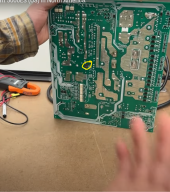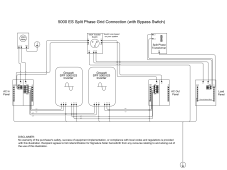SignatureSolarJames
Try Solar, the Grid will always take you back
UPDATED:
Issue #1: neutral-ground bonding, we have had these units ship under the American version, The PCB is not the same, some others here show removing the screw bond, but then find that the board still has a conductor trace that leaks to ground. This is why you need to buy these from an authorized American distributor, as listed on growatt-america.com
Issue #2 Neutral conflict between grid and off grid autotransformer. we are loading a schematic on this one: IF YOU ARE TAKING YOUR WHOLE HOUSE OFF GRID THERE SHOULD NEVER BE A NEUTRAL PASSED THROUGH FROM THE GRID. this is true for the split phase 12kW and 6kw inverters as well. the bottom line here is that all that is needed from the grid input is L1/L2. A dedicated ground rod is needed to bond to neutral of the off-grid autotransformer.
You can keep all of your grounds including the utility bonded, several big-name hybrids with transformers do this as well, like QCells, Delta and SolarEdge. If you are concerned about the boogeyman transformer mis-winding idea, then theoretically you could separate just the utility meter as in the below diagram (NOT REQUIRED/ THEORECTICAL)
As far as autotransformer size is concerned let's take a second and discuss what the ratings mean. the "imbalance power is reflective of the balance between the total 120v loaded L1 and L2 legs, NOT the total kW of 120v loads.
-Any 240v loads like an air conditioner, heater or pump pull evenly and therefore have ZERO load on the auotransformer
2x 5000es + 1 transformer with 5000w on L1 and 5000w on L2 has a transformer load of 0 watts, not 10000w,
5000W on L1 and 4000w on L2 is a load of 1000W on the transformer, not 9000w
-A 5000es + 1 transformer with 3kw of imbalance can run a max power split of 4kw/1kw on L1/L2
-2x5000es + 1 transformer can split max at 3.5kw/6.5 on L1/L2
This beats the imbalance tolerance of sol-ark, MPP, Growatt LF and most others, that's why this autotransformer has become a common trick by the Sol-Ark clientele
You can't run an unlimited amount with 1 transformer and per the manufacturer you need breaker protection, if you combine your inverters, transformers and 240v loads on the ac out panel and then feed your 120v loads panel you will be able to achieve full protection (VIDEO COMING)
If you have more than 5kw of 120v then odds are you need a second transformer.
Most off-grid folks have the 120v loads under control because they plan their lifestyle before going of grid. This design is a huge win on cost because the major off grid loads, like AC, Dryers, Ovens, and other large 240v loads now only cost $900 for 5kw with a 6kw 450v solar charger built in that needs no combiner box.


Issue #1: neutral-ground bonding, we have had these units ship under the American version, The PCB is not the same, some others here show removing the screw bond, but then find that the board still has a conductor trace that leaks to ground. This is why you need to buy these from an authorized American distributor, as listed on growatt-america.com
Issue #2 Neutral conflict between grid and off grid autotransformer. we are loading a schematic on this one: IF YOU ARE TAKING YOUR WHOLE HOUSE OFF GRID THERE SHOULD NEVER BE A NEUTRAL PASSED THROUGH FROM THE GRID. this is true for the split phase 12kW and 6kw inverters as well. the bottom line here is that all that is needed from the grid input is L1/L2. A dedicated ground rod is needed to bond to neutral of the off-grid autotransformer.
You can keep all of your grounds including the utility bonded, several big-name hybrids with transformers do this as well, like QCells, Delta and SolarEdge. If you are concerned about the boogeyman transformer mis-winding idea, then theoretically you could separate just the utility meter as in the below diagram (NOT REQUIRED/ THEORECTICAL)
As far as autotransformer size is concerned let's take a second and discuss what the ratings mean. the "imbalance power is reflective of the balance between the total 120v loaded L1 and L2 legs, NOT the total kW of 120v loads.
-Any 240v loads like an air conditioner, heater or pump pull evenly and therefore have ZERO load on the auotransformer
2x 5000es + 1 transformer with 5000w on L1 and 5000w on L2 has a transformer load of 0 watts, not 10000w,
5000W on L1 and 4000w on L2 is a load of 1000W on the transformer, not 9000w
-A 5000es + 1 transformer with 3kw of imbalance can run a max power split of 4kw/1kw on L1/L2
-2x5000es + 1 transformer can split max at 3.5kw/6.5 on L1/L2
This beats the imbalance tolerance of sol-ark, MPP, Growatt LF and most others, that's why this autotransformer has become a common trick by the Sol-Ark clientele
You can't run an unlimited amount with 1 transformer and per the manufacturer you need breaker protection, if you combine your inverters, transformers and 240v loads on the ac out panel and then feed your 120v loads panel you will be able to achieve full protection (VIDEO COMING)
If you have more than 5kw of 120v then odds are you need a second transformer.
Most off-grid folks have the 120v loads under control because they plan their lifestyle before going of grid. This design is a huge win on cost because the major off grid loads, like AC, Dryers, Ovens, and other large 240v loads now only cost $900 for 5kw with a 6kw 450v solar charger built in that needs no combiner box.


Attachments
Last edited:


